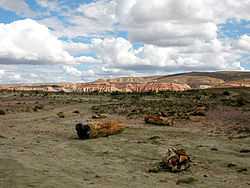Sarmiento, Chubut
| Sarmiento | |
|---|---|
| Town | |
|
In the petrified forest | |
 Sarmiento Location of Sarmiento in Argentina | |
| Coordinates: 45°36′S 69°5′W / 45.600°S 69.083°WCoordinates: 45°36′S 69°5′W / 45.600°S 69.083°W | |
| Country |
|
| Province | Chubut |
| Department | Sarmiento |
| Population | |
| • Total | 8,292 |
| Time zone | ART (UTC-3) |
| CPA base | U9020 |
| Dialing code | +54 297 |
Sarmiento is a town in the province of Chubut, Argentina. It has about 8,000 inhabitants as per the 2001 census [INDEC], and is the head town of the department of the same name. It is located on the so-called Central Corridor of Patagonia, in a fertile valley amidst an otherwise arid region, 140 km west from Comodoro Rivadavia, in the south of Chubut. It sits between two lakes, Lake Musters and Lake Colhue Huapi. Notable attractions are the Petrified Forest and caves with Aborigine hand paintings.
History
Sarmiento was born as a colony of immigrants, mainly from Wales (see y Wladfa). In the early 1900s it also experienced an influx of immigrants from Lithuania.
In 1900 Argentine authority was locally established when the Swedish former sailor Oscar Lundqwist, who had been appointed police commissioner to Sarmiento, set up the first "comisaría" ever in Sarmiento. It was situated next to "Las Tres Casas" where the Jones families from Wales and the briton Pryce lived.
In 1903 600 Afrikaner families arrived in Argentina following the loss of the Second Boer War. They settled in the region as it had access to water unlike the coastal city of Comodoro Rivadavia where they first settled. The descendants of these colonists make up a large portion of the population of Sarmiento and still speak Afrikaans and attend the Nederduitse Gereformeerde Kerk ("Dutch Reformed Church") to this day. As recently as the 1960s Afrikaans was the most commonly spoken language however this has changed as the town's Afrikaans population has become more assimilated into Argentinian culture and society.[1]
Climate
Under the Köppen climate classification, Sarmiento has a cold semi-arid climate (Köppen BSk) that closely borders on a cold desert climate with warm summers and cool winters.[2] The coldest temperature at low elevation ever recorded in South America, -33°C (-27°F), was recorded in Sarmiento on June 17, 1907.[3] Precipitation is low, averaging only 183 millimetres (7 in) per year.
| Climate data for Sarmiento, Chubut (1941-1950) | |||||||||||||
|---|---|---|---|---|---|---|---|---|---|---|---|---|---|
| Month | Jan | Feb | Mar | Apr | May | Jun | Jul | Aug | Sep | Oct | Nov | Dec | Year |
| Record high °C (°F) | 37.6 (99.7) |
36.7 (98.1) |
33.4 (92.1) |
26.8 (80.2) |
22.0 (71.6) |
20.0 (68) |
16.5 (61.7) |
19.7 (67.5) |
23.3 (73.9) |
29.0 (84.2) |
32.0 (89.6) |
35.8 (96.4) |
37.6 (99.7) |
| Average high °C (°F) | 25.3 (77.5) |
24.4 (75.9) |
21.5 (70.7) |
17.3 (63.1) |
12.0 (53.6) |
9.0 (48.2) |
8.8 (47.8) |
10.4 (50.7) |
14.2 (57.6) |
18.8 (65.8) |
21.2 (70.2) |
23.8 (74.8) |
17.2 (63) |
| Daily mean °C (°F) | 17.8 (64) |
16.8 (62.2) |
14.2 (57.6) |
11.0 (51.8) |
7.3 (45.1) |
4.7 (40.5) |
4.1 (39.4) |
5.0 (41) |
8.1 (46.6) |
12.0 (53.6) |
14.1 (57.4) |
16.4 (61.5) |
11.0 (51.8) |
| Average low °C (°F) | 11.6 (52.9) |
10.8 (51.4) |
8.8 (47.8) |
5.9 (42.6) |
3.2 (37.8) |
1.0 (33.8) |
0.2 (32.4) |
0.6 (33.1) |
3.1 (37.6) |
6.4 (43.5) |
8.4 (47.1) |
10.5 (50.9) |
5.9 (42.6) |
| Record low °C (°F) | 1.5 (34.7) |
1.5 (34.7) |
−2.0 (28.4) |
−5.8 (21.6) |
−12.4 (9.7) |
−17.0 (1.4) |
−18.6 (−1.5) |
−10.7 (12.7) |
−6.9 (19.6) |
−3.8 (25.2) |
−1.0 (30.2) |
2.2 (36) |
−18.6 (−1.5) |
| Average precipitation mm (inches) | 12 (0.47) |
11 (0.43) |
19 (0.75) |
15 (0.59) |
28 (1.1) |
14 (0.55) |
24 (0.94) |
14 (0.55) |
14 (0.55) |
5 (0.2) |
18 (0.71) |
9 (0.35) |
183 (7.2) |
| Average relative humidity (%) | 42 | 43 | 47 | 56 | 65 | 71 | 69 | 61 | 52 | 44 | 41 | 38 | 52.4 |
| Mean monthly sunshine hours | 270 | 232 | 214 | 171 | 133 | 99 | 121 | 171 | 183 | 226 | 234 | 260 | 2,314 |
| Source #1: Sistema de Clasificación Bioclimática Mundial[4] | |||||||||||||
| Source #2: Danish Meteorological Institute (sun and relative humidity)[5] | |||||||||||||
Notes
- ↑ Hunt, Ricky (4 February 2011). "The last Boers of Patagonia". Mail & Guardian. Retrieved 6 February 2011.
- ↑ Kottek, M.; J. Grieser; C. Beck; B. Rudolf; F. Rubel (2006). "World Map of the Köppen-Geiger climate classification updated" (PDF). Meteorol. Z. 15 (3): 259–263. doi:10.1127/0941-2948/2006/0130. Retrieved December 22, 2012.
- ↑ "Lowest Recorded Temperatures". Retrieved 2007-02-20.
- ↑ "Argentina - Sarmiento" (in Spanish). Centro de Investigaciones Fitosociológicas. Retrieved December 24, 2012.
- ↑ Cappelen, John; Jensen, Jens. "Argentina - Sarmiento (pg 17)" (PDF). Climate Data for Selected Stations (1931-1960) (in Danish). Danish Meteorological Institute. Archived from the original (PDF) on April 27, 2013. Retrieved December 24, 2012.
References
- Municipal information: Municipal Affairs Federal Institute (IFAM), Municipal Affairs Secretariat, Ministry of Interior, Argentina. (Spanish)
- Colonia Sarmiento — Official website (includes tourist information in English).
